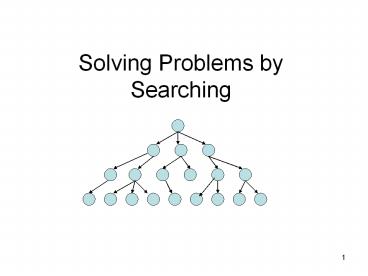Solving Problems by Searching - PowerPoint PPT Presentation
Title:
Solving Problems by Searching
Description:
Title: Introduction to Artificial Intelligence Author: Linda Shapiro Last modified by: Linda Shapiro Created Date: 9/19/2005 8:30:33 PM Document presentation format – PowerPoint PPT presentation
Number of Views:109
Avg rating:3.0/5.0
Title: Solving Problems by Searching
1
Solving Problems by Searching
2
Terminology
- State
- State Space
- Goal
- Action
- Cost
- State Change Function
- Problem-Solving Agent
- State-Space Search
3
Formal State-Space Model
Problem (S, s, A, f, g, c)
S state space s initial state A actions f
state change function f S x A -gt S g goal
test function g S -gt true,false c
cost function c S x A x S -gt R
a
- How do we define a solution?
- How about an optimal solution?
x
y
4
3 Coins ProblemA Very Small State Space Problem
- There are 3 (distinct) coins coin1, coin2,
coin3. - The initial state is H
H T - The legal operations are to turn over exactly one
coin. - 1 (flip coin1), 2 (flip coin2), 3 (flip coin3)
- There are two goal states H H
H -
T T T
What are S, s, A, f, g, c ?
5
State-Space Graph
1
HHT
THT
3
2
3
THH
HTT
2
1
1
2
3
HHH
TTT
2
3
HTH
TTH
1
- What are some solutions?
- What if the problem is changed to allow only 3
actions?
6
Modified State-Space Problem
- How would you define a state for the new problem?
- How do you define the operations (1, 2, 3) with
this new state definition? - What do the paths to the goal states look like
now?
7
How do we build a search tree for the modified 3
coins problem?
initial state
1 2 3
8
The 8-Puzzle Problem
7 2 4 5 B 6 8 3 1
B 1 2 3 4 5 6 7 8
one initial state
Bblank
goal state
- Formalize a state as a data structure
- Show how start and goal states are represented.
- How many possible states are there?
- How would you specify the state-change function?
- What is the goal test?
- What is the path cost function?
- What is the complexity of the search?
9
Search Tree Example Fragment of 8-Puzzle
Problem Space
10
Another Example N Queens
- Input
- Set of states
- Operators and costs
- Start state
- Goal state (test)
- Output
11
Example Route Planning
- Input
- Set of states
- Operators and costs
- Start state
- Goal state (test)
- Output
12
Search Strategies
- Blind Search (Ch 3)
- Informed Search (Ch 4)
- Constraint Satisfaction (Ch 5)
- Depth first search
- Breadth first search
- Depth limited search
- Iterative deepening search
13
Depth First Search
- Maintain stack of nodes to visit
- Evaluation
- Complete?
- Time Complexity?
- Space ?
a
Not for infinite spaces
b
e
O(bd)
g
h
c
d
f
O(d)
14
Breadth First Search
- Maintain queue of nodes to visit
- Evaluation
- Complete?
- Time Complexity?
- Space?
a
Yes
b
c
O(bd)
g
h
d
e
f
O(bd)
15
The Missionaries and Cannibals Problem(from text
problem 3.9)
- Three missionaries and three cannibals are on one
side of a river, along with a boat that can hold
one or two people. - If there are ever more cannibals than
missionaries on one side of the river, the
cannibals will eat the missionaries. (We call
this a dead state.) - Find a way to get everyone to the other side,
without anyone getting eaten.
16
Missionaries and Cannibals Problem
17
Missionaries and Cannibals Problem
Left Bank Right Bank
River
18
Missionary and Cannibals Notes
- Define your state as (M,C,S)
- M number of missionaries on left bank
- C number of cannibals on left bank
- S side of the river that the boat is on
- When the boat is moving, we are in between
states. When it arrives, everyone gets out.
19
When is a state considered DEAD?
- There are more cannibals than missionaries on the
left bank. (Bunga-Bunga) - There are more cannibals than missionaries on the
right bank. (Bunga-Bunga) - There is an ancestor state of this state that is
exactly the same as this state. (Why?)
20
Assignment
- Implement and solve the problem with a
depth-first search using a stack and/or
recursion. - Find and print all 4 solutions. (See web page.)
- Keep track of the total number of states
searched. - When you get to a dead state, count it and then
back up to its parent. - You may use the computer language of your choice
for this assignment. - Java
- C
21
Is memory a limitation in search?
- Suppose
- 2 GHz CPU
- 1 GB main memory
- 100 instructions / expansion
- 5 bytes / node
- 200,000 expansions / sec
- Memory filled in 100 sec lt 2 minutes
22
Iterative Deepening Search
- DFS with limit incrementally grow limit
- Evaluation
- Complete?
- Time Complexity?
- Space Complexity?
a
b
e
Yes
c
d
f
i
O(bd)
l
g
h
j
k
O(d)
23
Cost of Iterative Deepening
b ratio ID to DFS
2 3
3 2
5 1.5
10 1.2
25 1.08
100 1.02
24
Forwards vs. Backwards
start
end
25
vs. Bidirectional
26
Problem
- All these methods are too slow for real
applications (blind) - Solution ? add guidance
- ? informed search































